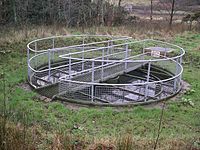
Photo from wikipedia
The concept of thermophilic membrane-aerated biofilm reactor (ThMABR) is studied by modeling. This concept combines the advantages and overcomes the disadvantages of conventional MABR and thermophilic aerobic biological treatment and… Click to show full abstract
The concept of thermophilic membrane-aerated biofilm reactor (ThMABR) is studied by modeling. This concept combines the advantages and overcomes the disadvantages of conventional MABR and thermophilic aerobic biological treatment and has great potential to develop a new type of ultra-compact, highly efficient bioreactor for high-strength wastewater and waste gas treatments. Mathematical modeling was conducted to investigate the impact of temperature (mesophilic vs. thermophilic) and oxygen partial pressure on oxygen and substrate concentration profiles, membrane–biofilm interfacial oxygen concentration, oxygen penetration distance, and oxygen and substrate fluxes into biofilms. The general trend of oxygen transfer and substrate flux into biofilm between ThAnMBR and MMABR was verified by the experimental results in the literature. The results from modeling studies indicate that the ThMABR has significant advantages over the conventional mesophilic MABR in terms of improved oxygen and pollutant flux into biofilms and biodegradation rates, and an optimal biofilm thickness exists for maximum oxygen and substrate fluxes into the biofilm.
Journal Title: Membranes
Year Published: 2022
Link to full text (if available)
Share on Social Media: Sign Up to like & get
recommendations!